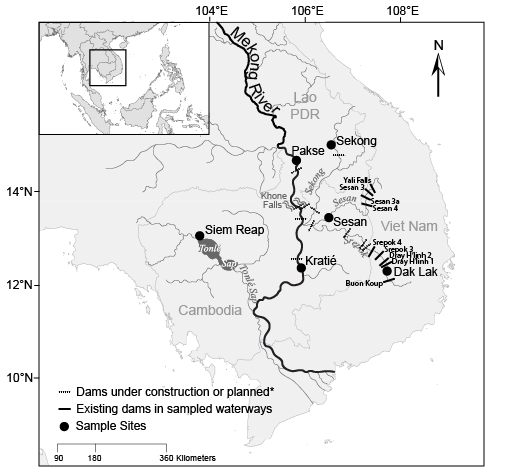About the author: Rose Ferguson wrote this post as part of Dr. Stacy Krueger-Hadfield‘s Principles of Scientific Investigation course. She is currently a dual Bachelor’s and Master’s student through the Accelerated Bachelor’s to Master’s program at UAB. She is planning on conducting research in Dr. Dustin Kemp’s lab beginning spring of 2021. With COVID-19 safety measures in place, this has delayed her research efforts in hopes of socially distancing in the labs. Rose will have her B.S. in Biology at UAB by 2021 then continue on to complete her Master’s degree by the end of that same year. She has always been passionate about the environment and looks forward to participating in research that aligns with her goals.
Habitat fragmentation can occur naturally or anthropogenically, intentional or not. Dams, which are large sources of hydropower, are one process that can lead to profound ‘downstream’ fragmentation. While dams can have a positive impact for humans, the impacts on freshwater species can be very harmful, sometimes leading to irreversible damage on the ecosystem.
|
Ackiss et al. (2019) sought to figure out if the catfish Hemibagrus spilopterus in the Mekong River system (Vietnam, Lao PDR, and Cambodia) could adapt to fragmentation caused by proposed dam construction. H. spilopterusis one of the most important fishery resources in the Lower Mekong Basin which makes it a prime candidate for study. Using an existing dam in the Dak Lak tributary, the authors compared muscle tissue in the H. spilopterus catfish between Dak Lak and five other locations that do not yet have dams but for which dams are under construction or planned along the Mekong River system (Figure 1). As the Dak Lak tributary was already fragmented by the existing dam, the other locations were used as a “before fragmentation” scenario and Dak Lak as an “after fragmentation”. Ackiss et al. (2019) were focused on studying how well the isolated population of H. spilopterus adapted to the habitat fragmentation caused by the Dak Lak tributary dam. The isolation of the catfish had potential to decrease genetic diversity and gene flow, ultimately leading to a decrease in fitness. |
Figure 1. Sample sites for Hemibagrus spilopterus along the Mekong River system. Existing dams are shown with a solid black line while dams under construction/planned are shown with a dotted black line. Sample sites are shown as black dots. Modified from Ackiss et al. (2019). |
Within these sample sites, summary statistics were run on H. spilopterus catfish to compare data between each site. Comparable statistics being the levels of observed and expected heterozygosity for each sample site as well as the degree of inbreeding. Genetic similarities were analyzed among the individuals using a UPGMA dendrogram. This analysis concluded the presence of two highly divergent clusters of H. spilopteruscoexisting in three of the sampled locations: Cluster A with low representation across three of the sites, and Cluster B with representation across all sites. With Cluster A representation being so low, only Cluster B.
The observed heterozygosity of H. spilopterus in the Dak Lak tributary is much lower than the other sample sites. Along with that, the level of inbreeding is much higher in the already fragmented area as well. Fragmentation caused by the damming of this river likely caused the increased inbreeding, thereby decreasing the genetic diversity. These results highlight what may come to pass in proposed dam construction sites.
For future studies of the impacts of dams on freshwater species, we need baseline assessments of genetic variation. This will at the very least enable researchers to determine the genetic consequences on populations of economically and ecologically important taxa.
Source: http://blog.theaga.org/habitat-fragmentation-of-the.../

